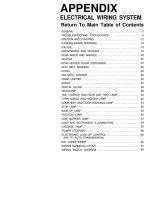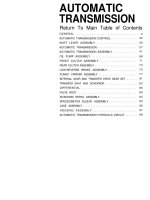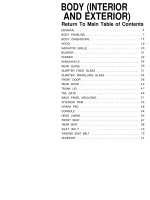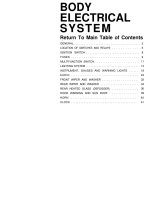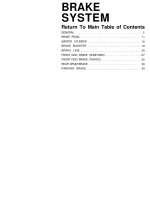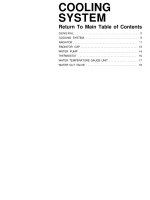Xe ô tô hyundai excel toàn tập hyundai excel - P3
Bạn đang xem bản rút gọn của tài liệu. Xem và tải ngay bản đầy đủ của tài liệu tại đây (4.8 MB, 107 trang )
AUTOMATIC
TRANSMISSION
Return To Main Table of Contents
GENERAL
.......................................
2
AUTOMATIC TRANSMISSION CONTROL
................
32
SHIFT LEVER ASSEMBLY
........................... 35
AUTOMATIC TRANSMISSION
........................
37
AUTOMATlC TRANSMISSION ASSEMBLY
..............
41
OIL PUMP ASSEMBLY
...............................
68
FRONT CLUTCH ASSEMBLY
........................
71
REAR CLUTCH ASSEMBLY
............................
73
LOW-REVERSE BRAKE ASSEMBLY
...................
75
PLANET CARRIER ASSEMBLY
........................
77
INTERNAL GEAR AND TRANSFER DRIVE GEAR SET
........
81
TRANSFER SHAT AND GOVERNOR
...................
83
DIFFERENTIAL
.................................
86
VALVE BODY
..................................
89
KICKDOWN SERVO ASSEMBLY
.....................
94
SPEEDOMETER SLEEVE ASSEMBLY
....................
95
CASE ASSEMBLY
.................................
96
HOUSING ASSEMBLY
.............................
97
AUTOMATIC TRANSMISSION HYDRAULIC CIRCUIT
........
99
GENERAL
SPECIFICATIONS
Transmission code No.
Gear ratio
1st
2nd
3rd
Reverse
Final gear ratio
Torque converter
Type
Engine stall speed
Stall torque ratio
Speedometer gear ratio
Recommended ATF
ATF capacity
KM171-1-AP2
2.846
1.581
1.000
2.176
3.166
With internal damper clutch
2,200 ± 200 rpm
2.17
19 drive/17 driven
DEXRON
®
ll, DEXRON
®
5.8 lit. (6.1 U.S.qts., 5.1 Imp.qts.)
SERVICE STANDARD
mm (in.)
Automatic transmission
Standard value
Clearance between sleeve and selector lever end
17.2-17.9 (0.677-0.705)
Input shaft end play
0.5-1.4 (0.020-0.055)
Transfer shaft pre-load
0.1-0.15 (0.004-0.006)
Differential end play
0-0.15 (0-0.006)
Oil pump gear side clearance
0.025-0.05 (0.001-0.002)
Front clutch snap ring clearance
0.4-0.6 (0.016-0.023)
Rear clutch snap ring clearance
0.3-0.5 (0.012-0.020)
Low-reverse brake snap ring clearance
0.8-1.0 (0.031-0.039)
NOTE
If DEXRON
®
II or DEXRON
®
is not appropriate in U.S.A. and
CANADA, use a MOC’S DEXRON or Chrysler’s 7176 type.
45-2
GENERAL
TIGHTENING TORQUE
Nm
kg.cm
Ib.ft
Selector handle set screw
Transmission mounting bolt
Starter motor mounting bolt
Bell housing cover to transmission (8 x 20)*
Bell housing cover to transmission (8 x 14)*
Engine to transmission
Torque coverter to drive plate
Drive plate-to-converter tightening bolt
Transmission assembly mounting bolt (7T)
Transmission assembly mounting bolt (10T)
Drain plug, case
Pressure check plug
Bearing retainer bolt
Oil cooler connector
Converter housing bolt
Oil pan bolt
2 or more 20 or more
43-55
430-560
22-32
220-330
15-22
150-220
10-12
100-120
Refer to the table of components
Kickdown servo nut
Center support bolt
Lock plate bolt
Differential drive gear bolt
Governor bolt
Governor bolt lock nut
Manual control lever nut
Manual control shaft set screw
Inhibitor switch
Sprag rod support bolt
Pump housing-to-reaction shaft support bolt
Oil pump assembly mounting bolt
Valve body bolt
Throttle cam bolt
Valve body assembly mounting bolt
Oil filter bolt
Speedometer sleeve locking plate bolt
35-42
46-51
43-53
30-34
30-34
8-9.5
15-21
15-21
19-22
10-11
15-21
20-26
20-26
128-138
8-9.5
4-5.5
17-20
8-9.5
10-11
20-26
10-11
15-21
4-5.5
8-9.5
10-11
5-6.5
3-4.5
360-430
460-530
430-550
300-350
300-350
80-100
150-220
150-220
190-230
100-120
150-220
200-270
200-270
1,300-1,400
80-100
40-60
170-210
80-100
100-120
200-270
100-120
150-220
40-60
80-100
100-120
50-70
30-50
1.5 or more
31-40
16-23
11-16
7-9
25-30
34-38
32-39
22-25
22-25
6-7
11-15
11-15
14-16
7.5-8.5
11-15
15-19
15-19
94-101
6-7
3-4
13-15
6-7
7.5-8.5
15-19
7.5-8.5
11-15
3-4
6-7
7.5-8.5
4-5
2.5-3.5
NOTE
*Bolt O.D. x Length mm
LUBRICANTS
Recommended lubricant
Quantity
Automatic transmission fluid
DEXRON
®
lI, DEXRON
®
5.8 lit.
(6.1 U.S.qts., 5.1 Imp.qts.)
Selector lever sliding portion
Wheel bearing grease SAE J310a,
NLGI grade #2 EP
As required
45-3
GENERAL
SPECIAL TOOLS
45-4
GENERAL
GENERAL
45-6
GENERAL
TROUBLESHOOTING
GENERAL INFORMATION
1.
Inadequate maintenance or adjustment.
2.
Electronic control function failure.
3.
Mechanical control function failure.
4.
Hydraulic control function failure.
5.
Engine performance failure.
Functional troubles of the automatic transaxle are caused by
the following.
For troubleshooting, you have to begin with hearing from the
client the conditions leading to the trouble and the state of the
trouble in as many details as possible and checking if such
trouble is reproducible. Then, conduct the tests following the
inspection procedures shown to the left in order.
PROCEDURE
Locate trouble according to “CHART”
As shown in the following, conduct basic
inspection and make adjustment as necessary.
(1) Fluid level and condition.
(2) Manual control cable adjustment.
(3) Throttle control cable adjustment.
Perform road test
If damper clutch system is found abnormal
in road test, check all elements (sensor etc.)
one by one and repair as necessary.
If trouble in hydraulic control system is
suspected, make hydraulic pressure test and
check.
If specified hydraulic pressure is not
reached in hydraulic pressure test, check
valve body and associated parts and hy-
draulic paths of each system for leaks.
In case of excessive stains of ATF, abnormal
noise, oil leaks, clutch or brake slip or other
troubles of transaxle itself, disassemble and
check transaxle and repair as necessary.
45-7
GENERAL
Remarks: *KM171 only.
indicates items to be given high priority in inspection.
45-8
GENERAL
Remarks:
*KM171 only.
indicates items to be given high priority in inspection.
45-9
GENERAL
SERVICE ADJUSTMENT PROCEDURES
Diagnosis
Automatic transmission malfunctions may be caused by four
general conditions; poor engine performance, improper adjust-
ments, hydraulic malfunctions, and mechanical malfunctions.
Diagnosis of these problems should always begin by checking
easily accessible variables; fluid level and condition manual
control cable adjustment, and throttle control cable adjustment.
Then perform road test to determine whether the problem has
been corrected or more diagnosis is necessary. If the problem
still exists after preliminary tests and corrections are com-
pleted, hydraulic pressure tests should be performed.
Fluid Level and Condition
1. Place vehicle on level floor.
2. Before removing dipstick, wipe all dirt from area around
dipstick.
3. With selector lever in “P” Park and parking brakes applied, start
engine.
4. Engine should be running at idle speed. Fluid should be at
normal operating temperature [50-80°C (120-180°F)].
5. Move selector lever sequentially to every position to fill torque
converter and hydraulic circuit with fluid, then place level in “N”
Neutral position. This operation is necessary to be sure that
fluid level check is accurate.
6. Check to see if fluid level is in the “HOT” range on dipstick. If
fluid is low, add ATF until level reaches “HOT” range. Low fluid
level can cause a variety of conditions because it allows pump to
take in air along with fluid. Air trapped in hydraulic circuit forms
bubbles which make fluid spongy. Therefore, pressures will be
erratic.
Improper filling can also raise fluid level too high. When trans-
mission has too much fluid, gears churn up foam and cause
same conditions which occur with low fluid level, resulting in
accelerated deterioration of ATF.
In either case, air bubbles can cause overheating, fluid oxida-
tion, and varnishing, which can interfere with normal valve,
clutch, and servo operation. Foaming can also result in fluid
escaping from vent where it may be mistaken for a leak.
Along with fluid level, it is important to check the condition of
the fluid. When fluid smells burned, and is contaminated with
metal bushing or friction material particles, a complete trans-
mission overhaul is needed. Be sure to examine fluid on dipstick
closely. If there is any doubt about its condition, drain out
sample for double check. After fluid has been checked, seat
dipstick fully to seal out water and dirt.
45-10
GENERAL
Manual Control Cable
Whether manual linkage is properly adjusted can be confirmed
by checking whether inhibitor switch is performing well.
1. Apply parking brakes and service brakes securely.
2. Place selector lever to “R” range.
3. Set ignition key to “ST” position.
4. Slowly move the selector lever upward until selector lever
makes a click as it fits in notch of “P” range. If starter motor
operates when lever makes a click. “P” position is correct.
5. Then slowly move selector lever to “N” range by the same proce-
dure as in foregoing paragraph. If starter motor operates when
selector lever fits in “N”, “N” position is correct.
6. Next, slowly move selector lever to “R” and “D” ranges. The
starter motor must not operate in either of these ranges.
7.
If starter motor operates in both “P”and “N” range and does not
operate in “R” and “D” positions as described above, it follows
that manual control cable is properly adjusted.
Throttle Control cable
Throttle control cable adjustment is very important adjustment
to assure normal operation of transmission.
Shift speed control and shift feeling depend largely on this
adjustment. If inner cable is tight, late and harsh shifts will
result. If inner cable is long (slack), early and slipping shifts will
result.
1. Check to ensure that throttle valve has standard idle opening.
When engine is cold, throttle valve does not have standard
opening, because fast idle system is operating. Check to ensure
that choke lever is away from cam follower.
2. Raise cable cover “B” to expose stopper.
3. Check to ensure that spacing between stopper and cover “A” is
up to specification.
4. Check to ensure that when throttle valve is fully opened and
inner cable pulled further upward, there is still some margin in
cable stroke.
45-11
GENERAL
Road Test
Prior to performing road test, be certain that fluid level and
condition and control cable adjustments have been checked
and approved. During road test, transmission should be oper-
ated in each position to check for slipping and any variation in
shifting. Approximate shift speeds for various modes of opera-
tion are shown in “Automatic shift speed pattern”.
Test 1 (Selector in “D”)
1. With accelerator pedal kept depressed either halfway or fully
and without changing pedal position, start vehicle and increase
vehicle speed.
Check to see if transmission makes 1-2 and 2-3 upshifts and if
shifts take place properly at correct vehicle speeds. Also check
for abnormal shock or any slips of friction elements at the time of
shifting.
2. While driving in third gear, check for noise and vibration.
3. Drive in second or third gear, check to see if 2-1, 3-1 and 3-2
kickdown shift occur properly at specified kickdown limit vehi-
cle speeds.
4. Drive in third gear, and select “2” range then “L” range to check
if engine brake is effective.
5. Drive in third gear [at 50 km/h (31 mph) or higher speeds], and
select “L” range to check if 2-1 downshift occurs at proper
vehicle speed.
Test (Selector in “2”)
1. Start vehicle and increase vehicle speed. Check to see if trans-
mission makes 1-2 upshift and if shift takes place properly at
correct vehicle speed. Also check for abnormal shock and noise
at the time of shifting as well as acceleration and deceleration,
2. Check to see if 2-1 kickdown occurs at correct limit vehicle
speed.
Test 3 (Selector in “L”)
1. While driving with selector lever in “L” position, make certain
no upshift to second gear (or third gear) occurs.
2. Check for noise in either acceleration or deceleration.
Test 4 (Selector in “R”)
1. Start engine and “stall test” transmission to see that friction
element is not slipping.
Test 5 (Selector in “P”)
1. With vehicle parked on about 5% grade, place selector lever in
“P” position and release parking brake.
Parking system must work properly and vehicle must not move.
2. If necessary, make this test in both forward and backward
directions.
45-12
GENERAL
AUTOMATIC SHIFT SPEED PATTERN
KM171-1-AP2
Vehicle speed (mph)
Element in use at each position of the selector lever
Operating
*: Down shift in L range only.
45-13
GENERAL
HYDRAULIC PRESSURE TESTS
Pressure testing is very important step in diagnostic procedure.
These tests usually reveal cause of most automatic transmis-
sion problems.
Before performing pressure tests, be certain that fluid level and
condition, and control cable adjustment have been checked and
approved.
Preparations for Testing
1. Fluid must be at operating temperature [50 to 80°C (120 to
180°F)]
2. Raise vehicle on hoist which allows front wheels to turn.
3. Install engine tachometer and position tachometer so it can
easily be read.
4. Disconnect linkage from manual control lever on transmission.
Disconnect throttle control cable from carburetor throttle lever
so they can be controlled from outside of vehicle.
5. Attach Oil Pressure Gauge to ports required for test being
conducted.
Test port locations are shown below.
Test 1 (Selector in “L”)
1. Attach oil pressure gauges to “line pressure” and “low-reverse
brake pressure” take-off ports.
2. Operate engine at 2,500 rpm for test.
3. Move manual control lever on transmission to “L” position.
4. Read pressures on gauge as throttle control cable is pulled from
“idle” to “wide-open” position.
5. Line pressure should be 402-460 kPa (58-67 psi, 4.1-4.7
kg/cm
2
) when cable is in “idle” position, and increase to 677-
696 kPa (98-100 psi, 6.9-7.0 kg/cm
2
) as cable is pulled to
“wide-open” position.
6.
Low-reverse brake pressure should be 167-226 kPa (24-33 psi,
1.7-2.3 kg/cm
2
).
7. This tests pump output, pressure regulation, condition of rear
clutch and low-reverse hydraulic brake circuit.
Test 2 (Selector in “2”)
1. Attach oil pressure gauge to “line pressure” take-off port and
“tee” (3-way joint) into cooler line fitting to read “lubrication”
pressure.
2. Operate engine at 2,500 rpm for test.
3. Move manual control lever on transmission to “2” position.
4. Read pressure on gauge as throttle control cable is pulled from
“idle” to “wide-open” position.
5. Line pressure should be 402-460 kPa (58-67 psi, 4.1-4.7
kg/cm
2
) with cable in “idle” position and 677-696 kPa (98-100
psi, 6.9-7.0 kg/cm
2
) in “wide-open” position.
45-14
GENERAL
6. Lubrication pressure should be 49-147 kPa (7-21 psi, 0.5-1.5
kg/cm
2
) regardless of throttle opening.
7. This tests pump output, pressure regulation, condition of rear
clutch and lubrication hydraulic circuit.
Test 3 (Selector in "D")
1. Attach oil pressure gauge to “line pressure” and “front clutch
pressure” ports.
2. Operate engine at 2,500 rpm for test.
3. Move manual control lever to “D” position.
4. Read pressure on gauge as throttle control cable is pulled from
“idle” position to “wide-open” position.
5. Line pressure should be 402-460 kPa (58-67 psi, 4.1-4.7
kg/cm
2
) with cable in “idle” position and gradually increase as
throttle cable is pulled toward “wide-open” position.
If the difference between front clutch pressure and line pres-
sure is less than 78 kPa (11 psi, 0.8 kg/cm
2
), front clutch pres-
sure is good.
6. This tests pump output, pressure regulation, condition of front
and rear clutches, and hydraulic circuit.
Test 4 (Selector in “R”)
1. Attach 3,000 kPa (400 psi, 30.6 kg/cm
2
) oil pressure gauge to
“low-reverse brake pressure” take-off port.
2. Operate engine at 2,500 rpm for test.
3. Move manual control lever to “R” position.
4. Low-reverse brake pressure should be 1,373-1,961 kPa (199-
284 psi, 12-20 kg/cm
2
) regardless of throttle opening.
5. This tests pump output, pressure regulation, condition of front
clutch, and low-reverse brake hydraulic circuit.
45-15
GENERAL
Test Result Indications
1. If proper line pressure, minimum to maximum, is found in any
one test, pump and pressure regulator are working properly.
2. Low pressure in “D, L and 2” but correct pressure in “R” indi-
cates rear clutch circuit leakage.
3. Low pressure in “D and R” but correct pressure in “L” indicates
front clutch circuit leakage.
4. Low pressure in "R" and “L” but correct pressure in “2” indicates
low-reverse brake circuit leakage.
5. Low line pressure in all positions indicates defective pump,
clogged filter, or stuck pressure regulator valve.
GOVERNOR PRESSURE TEST
Test only if transmission shifts at wrong vehicle speeds when
throttle control cable is correctly adjusted.
1. Connect oil pressure gauge to governor pressure take-off port:
2. Operate transmission in “D” to read pressures and compare
vehicle speeds shown in chart. If governor pressure are incor-
rect at given vehicle speeds, governor valve is probably sticking;
or filter in governor body is clogged. Governor pressure should
respond smoothly to changes in vehicle speeds and should
return to 0-20 kPa (0-2.8 psi, 0-0.2 kg/cm
2
) when vehicle is
stopped.
Governor pressure chart
Governor pressure
Vehicle speed
94 kPa (14 psi, 0.96 kg/cm
2
)
27 km/h (18 mph)
294 kPa (43 psi, 3.0 kg/cm
2
)
65 km/h (40 mph)
490 kPa (71 psi, 5.0 kg/cm
2
)
100 km/h (62 mph)
CONVERTER STALL TEST
Stall test consists of determining maximum engine speed
obtained at full throttle in “D” and “R” positions. This test
checks torque converter stator overrunning clutch operation, and
holding ability of transmission clutches and low-reverse brake.
WARNING
During this test, let no one stand in front of or behind vehicle.
1.
Check transmission fluid level. Fluid should be at normal operat-
ing temperature [50-80°C (120-180°F)]. Engine coolant should
also be at normal operating temperature [80-90°C (180-190°F)].
2. Apply chocks to both rear wheels.
3. Attach engine tachometer.
4. Apply parking and service brakes fully.
5. Start engine.
45-16
GENERAL
6. With selector lever in “D” position, depress accelerator pedal
fully to read engine maximum rpm. Do not hold throttle wide
open any longer than is necessary to obtain maximum engine
rpm reading, and never longer than 5 seconds at a time. If more
than one stall check is required, operate engine at approxi-
mately 1,000 rpm in neutral to cool transmission fluid between
runs.
Stall speed : 2,200 ± 200 rpm
7. Place selector lever to “R” position and perform stall test by the
same procedure as in foregoing item.
Stall Speed Above Specification in “D”
If stall speed is higher than specification, rear clutch of over-
running clutch of transmission is slipping. In this case, perform
hydraulic test to locate cause of slippage.
Stall Speed Above Specification in “R”
If stall speed is higher than specification, front clutch of trans-
mission or low-reverse brake is slipping. In this case, perform
hydraulic test to locate cause of slippage.
Stall Speed Below Specification in “D” and “R”
If stall speed is lower than specification, insufficient engine
output or defective torque converter is suspected. Check for
engine misfiring, ignition timing, valve clearance, etc. if these
are good, torque converter is defective.
FLUID LEAKAGE-- TRANSMISSION CONVERTER
1. Check for source of leakage. Since fluid leakage at or around
converter area may originate from engine oil leak, area should
be examined closely. Transmission factory fill fluid is dyed red
and, therefore, can be distinguished from engine oil.
2. Prior to removing transmission, perform following check:
When leakage is determined to originate from transmission,
check fluid level prior to removal of transmission and torque
converter. High oil level can result in oil leakage out of vent
located in top of oil pump. If fluid level is high, adjust to proper
level. After performing this operation, recheck for leakage.
45-17
GENERAL
DAMPER CLUTCH TORQUE CONVERTER - DIA
GNOSIS
Test 1
Inspection of damper clutch torque converter operation with
engine idling.
Test 2
INSPECTION OF THE DAMPER CLUTCH TORQUE CONVERTER
OPERATION BY USING ELC-A/T CHECKER
The ELC-A/T checker (Tool NO. 09452-21700) contains two
circuits: the clutch-on circuit which is used to inspect the
damper clutch torque converter and damper clutch torque con-
verter hydraulic control circuit, and the control circuit which is
used to check whether the control unit is outputting the operat-
ing signal to the solenoid valve that controls the hydraulic
pressure.
45-18
GENERAL
Connector C : Connect to the inspection connector (white)
located inside the engine compartment (near the brake master
cylinder reservoir tank).
Connector A : Connect to the solenoid valve connector (green) of
the automatic transmission.
Connector B : Connect to the harness connector (on the vehicle
body) which was previously connected to the solenoid valve
connector of the automatic transmission.
Clip: Connect to the positive terminal of the battery.
Monitor lamp: This red LED illuminates when the select switch
is set to the “CONTROL” position and the damper clutch torque
converter operating signal is output.
Indicator lamp: This lamp illuminates when the select switch is
set to the “CLUTCH ON” position (when current flows to the
solenoid valve).
Select switch: This has three positions: OFF, CLUTCH ON, and
CONTROL. It is used to inspect the damper clutch torque con-
verter and damper clutch torque converter hydraulic control
circuit, and the output signal of the control unit. When the
switch is pressed to the “CLUTCH ON” side, current begins to
flow. When the switch is released, it returns to its original (OFF)
position and automatically resets.
45-19
GENERAL
NOTE
The damper clutch tor-
que converter is designed
not to operate in the
following states:
(a) When the tempera-
ture of the coolant is
below 50°C (122°F)
(b) When the vehicle is
Connect the ELC-
A/T checker to the
appropriate ter-
minals
Set the select switch
of the checker to
“OFF”
Shift the selector
lever to “P” or “N”,
then start the engine
and warm it up to at
least 50°C (122°F)
While warming up the engine, check that the
indicator lamp (green) of the checker is not burnt out.
If the lamp illuminates when the select switch is
pressed to the “CLUTCH ON” side, it is operating
normally. If it is burnt out, unscrew the green lens
cover and replace the lamp. (The lamp is 12V, 5W.)
traveling in first gear
(c) When the selector
Prevent the vehicle
lever is set to “R”
from moving by
applying the parking
brake and service
brakes securely, then
shift the selector
lever to “D”.
Press the select
switch of the checker
to the “CLUTCH ON”
side. Does the engine
stall ?
Incorrect solenoid
valve operation
(broken wire)
Replace the sole-
noid valve
The hydraulic circuit
and damper clutch
operate correctly
Return the select
switch to the “OFF”
position and restart
the engine
SEE NEXT PAGE
Damper clutch
torque converter
Overhaul the valve
control valve is
body
stuck
Abnormal abrasion
(sliding) of damper
clutch torque
converter
Replace the torque
converter assembly
GENERAL
45-21
GENERAL
Test 3 Inspection of Damper Clutch Control System Components
(2) Coolant
temperature
sensor
With sensor immersed in hot
water [60°C (140°F) or higher],
check continuity between
terminal “B” and ground
No continuity
detected
(resistance:
infinite)
Continuity detected
(resistance: 0)
Coolant temperature
sensor terminal
Go to (3)
Open circuit
Replace coolant tempera-
ture sensor.
Terminal “A”
Terminal “B”
45-22
GENERAL
NOTE:
Check while set to the
carburetor.
Throttle position sensor
terminals
1-2 : Pulse generator “A”
3-4 : Pulse generator “B”
45-23
GENERAL
45-24
GENERAL
45-25



